
On May 25, 1906, Santa Ana’s leaders called for the burning of its downtown Chinatown.
At the time, they said it was a health emergency.
But Tuesday, nearly 116 years to the day that Santa Ana deliberately burnt down its Chinatown, elected officials gathered to apologize to Chinese immigrants and their descendants for “acts of fundamental injustice and discrimination.”
Santa Ana Mayor Vicente Sarmiento and fellow council members condemned the shameful episode in Santa Ana’s history, when city leaders directed the fire marshal to burn down the area on 2nd, Bush and Main streets.
“This is a momentous occasion for the city of Santa Ana, recognizing and seeking to atone for the racist and xenophobic actions of our predecessors,” Sarmiento said before signing a resolution apologizing to Chinese immigrants and their descendants “who came to Santa Ana and were the victims of systemic and institutional racism, xenophobia, and discrimination.”
Councilman Johnathan Ryan Hernandez said the decision to burn down Chinatown “crippled and hurt the Chinese community that helped build this city.”
Councilwoman Nelida Mendoza called it “one of the greatest tragedies in Santa Ana’s history.”
Santa Ana was home to some 200 Chinese men, who began arriving in the late 1800s to work for a fruit company, according to the book, “The Burning of Santa Ana’s Chinatown,” by Stephen Gould, a former Cal State Fullerton student who researched the topic for decades. (Gould died last year.)
As described in Gould’s book, this is what happened:
In 1903, city leaders planning to build a new City Hall purchased some land for $850 – a bargain price because it sat right next to the city-block-wide area known as Chinatown. But after building City Hall, they weren’t happy that just outside their windows sat a neighborhood with live animals, inadequate sewer facilities and labeled by some as “a menace to health.”
Police regularly raided Chinatown looking for illegal activity, but found none, Gould said in the book.
Then, on May 24, 1906, city officials inspecting the area said they found a Chinese man with “‘horrible sores’ of leprosy.” Emergency meetings were called, and Chinatown was placed on quarantine. Most of the men left, but those who remained were “thoroughly fumigated” and placed in a tent. The man believed to have leprosy was moved to a second tent, with “the town character” as his guard.
In one meeting, a city official said: “Purge that plague hole once and for all! Burn the damn place down and do it tonight.”
And so it was done, before as many as 1,000 onlookers, on May 25, 1906, Gould described.
“This is the only instance in state history I can find where this was done by city employees, and it was civically sponsored by city leaders,” said Dylan Almendral, a local historian at Tuesday’s ceremonial signing.
Throughout the American West, mobs burned down Chinatowns from Anaheim to Los Angeles, San Francisco and elsewhere, Almendral said.
“Most of the other instances of anti-Asian or anti-Black or other minority crime is basically guys in white hoods or an angry mob,” Almendral said, holding one of the few remaining copies of Gould’s book.
City officials said they were eager to adopt the resolution, unanimously passed on May 17, during this Asian American and Pacific Islander Heritage Month.
The resolution resolves, among other things, “to rectify the lingering consequences of the historical discriminatory policies of the City of Santa Ana, and to use this resolution as a teaching moment for the public to move forward towards justice for all.”
Almendral, the historian, said recognition of Chinatown’s history had been in the works for many years, but he didn’t find a receptive council until this past year, when council members Hernandez and Thai Viet Phan took the lead on the topic.
A monument also is in the planning, Sarmiento said.
For Walt Lau, 67, and his brother, Guy Lau, 75, the city’s stance is symbolic.
“We see a healing process started,” said Guy Lau, who runs the Santa Ana Food Market with his brother. The store opened in 1948 and is one of the oldest Chinese businesses in town if not the oldest. Both men were at the signing ceremony.
Almendral also spoke of healing.
“A piece of our history was destroyed in 1906. Our legacy has been scarred,” Almendral said. “And today is the first day of healing after 116 years.”
Related Articles
Garcetti, military officials kick off LA Fleet Week during Cabrillo Beach news conference
Long Beach Pride adds Latin pop star Paulina Rubio as Fiesta stage headliner
Anaheim federal corruption probe: Who the heck is Company A?
Bob Hope’s former Toluca Lake home lists for $29 million
Judge satisfied with city’s solution to take over homeless services in Orange
